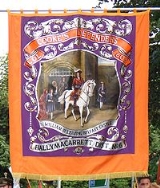
Banners in Northern Ireland
Encyclopedia
Banners are a significant part of the Culture of Northern Ireland
, particularly for the Protestant/unionist community, and one of the region's most prominent types of folk art
. They are typically carried in parades
such as those held on the Twelfth of July, Saint Patrick's Day
and other times throughout the year. Generally these are organised by societies such as the Orange Order, the Ancient Order of Hibernians
, the Royal Black Institution and the Apprentice Boys of Derry
, and the banners are typically commissioned, and represent, a lodge within one of these societies. Banners are also carried by trade unions and church groups, and by marching band
s. Most banners are painted by professionals and executed on silk, although canvas was a more popular material in the past. Most have a painting on each side, usually depicting different subjects, and the name and number of the lodge. Most banners have one subject per side, surrounded by flourishes, scrolls, and other decoration. Despite being in many ways a sectarian art form, Catholic
and Protestant banners are usually very similar in terms of style and composition. Apart from subject matter, the main difference is colour: Orange Order banners make heavy use of the colour orange and to a lesser extent red, white, blue and purple, while Catholic banners tend to feature a lot of green.
Possibly because of the significance of banners in Northern Irish culture, the operational name of the British Army
campaign in Northern Ireland during the Troubles
was Operation Banner
.
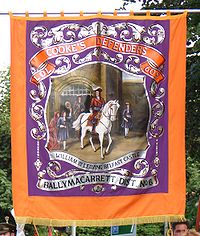 The banners of the Institution (better known as the Orange Order) depict a range of subjects, which can best be grouped into: historical, religious, memorial, local, and British. Some banners fit into more than one category.
The banners of the Institution (better known as the Orange Order) depict a range of subjects, which can best be grouped into: historical, religious, memorial, local, and British. Some banners fit into more than one category.
, whose victory in the Battle of the Boyne
is celebrated on the Twelfth of July, the biggest Orange celebration. William is shown on at least one side of most Orange banners, usually crossing the Boyne River
but sometimes in battle, arriving in England or Ireland, or in Belfast
, or in head and shoulders portrait form. On Junior Orange Lodge banners he is sometimes shown as a child. Banner paintings of William crossing the Boyne are often based directly or indirectly on a painting by Benjamin West
.
Other scenes from the Williamite War and Glorious Revolution
may also be depicted. These include the Siege of Derry
, particularly the shutting of the gates and the relief of the city, or portraits of Williamite commanders such as the Duke of Schomberg
.
Some banners relate to the history of the Order. Subjects include Dan Winter's cottage, where the Order was founded, and William Johnston of Ballykilbeg, who in the nineteenth century defied a law against Orange marches. Others relate to the Home Rule
crisis and depict scenes such as the signing of the Ulster Covenant
or have portraits of Unionist leaders such as Edward Carson. Another popular period is World War I
and in particular the Battle of the Somme in which many Ulster men lost their lives.
Miscellaneous historical topics depicted on Orange banners include World War II
, the B Specials and Oliver Cromwell
.
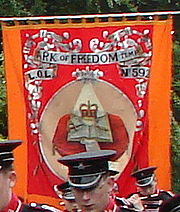
' in which William III took over the Crown from the Catholic James II
. Orangemen tend to see their patriotism and their commitment to Protestantism and inextricably interlinked.
Biblical
stories are sometimes depicted on Orange banners, as is a figure clinging to a large cross, often on a tiny island in a raging sea. Some historical banners are also religious, and depict Protestant martyr
s such as the Scottish Solway Firth
martyrs or key figures in the Reformation
such as Martin Luther
and John Calvin
.
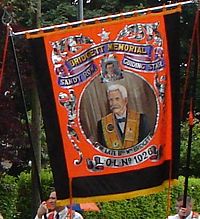 Banners are sometimes used to commemorate deceased lodge members, often men who were little known outside lodge circles, and particularly those killed in the 'Troubles'. If a member was particularly well regarded the name of the lodge may be changed to commemorate them. The member will typically be shown in their marching gear; the banner thus provides a way for him to continue marching with his lodge.
Banners are sometimes used to commemorate deceased lodge members, often men who were little known outside lodge circles, and particularly those killed in the 'Troubles'. If a member was particularly well regarded the name of the lodge may be changed to commemorate them. The member will typically be shown in their marching gear; the banner thus provides a way for him to continue marching with his lodge.
A number of historical banners also act as memorials, for example to Carson, Queen Victoria, important figures in Orange or Ulster history, or figures from the Williamite War. Occasionally recently deceased non-members are depicted, such as Earl Mountbatten of Burma
, who was killed by the Provisional Irish Republican Army
in 1979. A number of banners depicting the Battle of the Somme act as memorials, especially those banners belonging to war memorial lodges. Others show war memorials in Northern Ireland or elsewhere.
The laws of the Order forbid the depiction of any living person other than the British monarch on lodge banners.
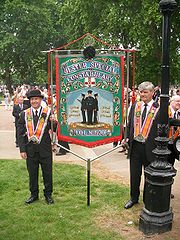 A less common banner theme is the purely local subject, such as a map of Northern Ireland, a local landmark or scene from local industry, or a symbol of Northern Ireland, such as the Red Hand of Ulster
A less common banner theme is the purely local subject, such as a map of Northern Ireland, a local landmark or scene from local industry, or a symbol of Northern Ireland, such as the Red Hand of Ulster
. Landmarks depicted often have religious or historical connotations, for example a church or the site of a historical event. Industrial scenes often seem not to mean anything other than a connection with members of the lodge, although they may be symbolic of the Protestant work ethic
. Ulster symbols such as flags are more commonly found on bannerettes or in the decoration around the main subject than as banner subjects in their own right.
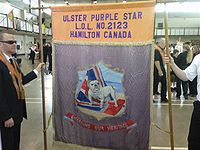
subjects. The two most popular of these are probably Britannia
(an allegorical figure representing Britain) and Queen Victoria handing a Bible
to a non-white (usually Indian) prince or chieftain. The second scene is sometimes captioned 'the Secret of Britain's Greatness' or 'The Secret of Britain's Might' and the image is intended to convey that the might of the British Empire was based on its Protestant faith. British scenes are much less common now than in the past, due partly to the decline of the British Empire but mostly because of a widespread sense of betrayal over recent British government policies on Northern Ireland. However Union Flag
s are still commonly found in the decoration around the main subject, and crowns are a common motif.
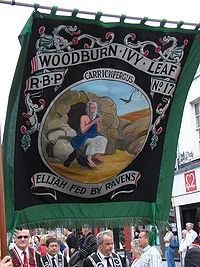 The majority of the Institution's banners depict Biblical stories, although a significant minority show deceased members of the lodge, with the banner acting as a memorial. 'Craft' symbols with little meaning to those outside the Institution are occasionally the subject of Black banners, as are local landmarks, historical figures, and more accessible symbols such as the Crown
The majority of the Institution's banners depict Biblical stories, although a significant minority show deceased members of the lodge, with the banner acting as a memorial. 'Craft' symbols with little meaning to those outside the Institution are occasionally the subject of Black banners, as are local landmarks, historical figures, and more accessible symbols such as the Crown
and Cross
. According to Anthony D. Buckley, the majority of Bible stories shown on Black banners are from the Old Testament
and most have one or both of the following themes: a Godly person or people living amongst strangers or sinners, or in a foreign land; and the rewards of faithfulness. The stories act as an analogy for the history and position of Protestants in Ireland. New Testament themes such as loving one's enemies are rarely expressed. Bible stories shown on the banners include: Adam and Eve
, Noah's Ark
, Elijah, Ruth and Naomi
, and scenes from the life of Jesus
.
, and consequently most of its banners show scenes from the Siege, or portraits of its heroes. However some of the topics shown on Orange banners also appear on Apprentice banners, particularly memorial portraits of deceased members.
are a conservative Catholic and nationalist organisation. Most of their banners feature religious images of saint
s (especially Saint Patrick
and the Virgin Mary) and pope
s (especially John Paul II, the first Pope to visit Ireland). Other banners feature symbols of Irish nationalism (such as Hibernia
, Irish round tower
s and the Cláirseach) or historical advocates of constitutional nationalism (such as Daniel O'Connell
).
are a constitutional nationalist organisation open to Irish people of any denomination. Forester banners typically depict various Irish symbols and famous nationalists. However, republican paramilitary groups are never depicted on Forester banners, and the group has distanced themselves from contemporary violence.
Many banners relate to the division in Northern Irish society between Protestants/Unionists/Loyalist
s on one side and Catholics/(Irish) Nationalists
and Republicans
on the other. For example, William III's victory over James II in the Williamite wars led to two centuries of Protestant ascendency in Ireland; depictions of William, the Siege of Derry and so forth thus express the belief that this was a good thing. While many banners are ostensibly pro one group rather than anti the other, they are generally taken to mean - and often do mean - opposition to the other side. For example, a Bible on a Protestant banner is usually not simply an assertion that the Bible is a good thing, but also an attack on Catholicism, which is seen as overly dependent on priests and ignorant of the word of God.
Many banners are also allegorical. Several members of the Orange Order have argued that their historical banners are actually metaphors for religious principles. Former Grand Master W. Martin Smyth has said that the Siege of Derry can be seen as symbolising the eternal conflict between good and evil. In the same way that the apprentices of Derry
shut the gates of the city against James' army despite the possible dire consequences, so righteous people should do God's bidding even if this is dangerous, and trust that God will save them. The relief of Derry is seen as symbolic of God's mercy and willingness to save all sinners if they trust in Him. Likewise, depictions of Britannia are not merely assertions of Britishness but also a statement that Britain was great because of its strong Protestantism, and has fallen in recent decades because of its godlessness.
On the other hand, it has been argued that many apparently religious banners are metaphors for politics and history. Many Bible stories can be seen as lessons on how to behave in the modern world and how to deal with sinners and unbelievers. As noted above, these are more likely to emphasise separatism and unyielding faith rather than forgiveness and loving one's enemies.
. In particular, trade union
banners were very similar. Due perhaps to the decline of British heavy industry and the general fading of many working class traditions, such banners are commonly seen only at events such as the Durham Miner's Gala.
Culture of Northern Ireland
The culture of Northern Ireland relates to the traditions of Northern Ireland and its resident communities.Elements of the culture of Ireland, the culture of Ulster and the culture of the United Kingdom are to be found.-Heritage:...
, particularly for the Protestant/unionist community, and one of the region's most prominent types of folk art
Folk art
Folk art encompasses art produced from an indigenous culture or by peasants or other laboring tradespeople. In contrast to fine art, folk art is primarily utilitarian and decorative rather than purely aesthetic....
. They are typically carried in parades
Parades in Northern Ireland
Parades are an important part of Northern Irish culture. Although the majority of parades are held ostensibly by Protestant, unionist or Ulster loyalist groups, nationalist, republican and non-political groups also parade. Parading is often considered to be an assertion of a group's control over a...
such as those held on the Twelfth of July, Saint Patrick's Day
Saint Patrick's Day
Saint Patrick's Day is a religious holiday celebrated internationally on 17 March. It commemorates Saint Patrick , the most commonly recognised of the patron saints of :Ireland, and the arrival of Christianity in Ireland. It is observed by the Catholic Church, the Anglican Communion , the Eastern...
and other times throughout the year. Generally these are organised by societies such as the Orange Order, the Ancient Order of Hibernians
Ancient Order of Hibernians
The Ancient Order of Hibernians is an Irish Catholic fraternal organization. Members must be Catholic and either Irish born or of Irish descent. Its largest membership is now in the United States, where it was founded in New York City in 1836...
, the Royal Black Institution and the Apprentice Boys of Derry
Apprentice Boys of Derry
The Apprentice Boys of Derry is a Protestant fraternal society with a worldwide membership of over 80,000, founded in 1814. They are based in the city of Derry, Northern Ireland. However, there are Clubs and branches across Ireland, Great Britain and further afield...
, and the banners are typically commissioned, and represent, a lodge within one of these societies. Banners are also carried by trade unions and church groups, and by marching band
Marching band
Marching band is a physical activity in which a group of instrumental musicians generally perform outdoors and incorporate some type of marching with their musical performance. Instrumentation typically includes brass, woodwinds, and percussion instruments...
s. Most banners are painted by professionals and executed on silk, although canvas was a more popular material in the past. Most have a painting on each side, usually depicting different subjects, and the name and number of the lodge. Most banners have one subject per side, surrounded by flourishes, scrolls, and other decoration. Despite being in many ways a sectarian art form, Catholic
Catholic
The word catholic comes from the Greek phrase , meaning "on the whole," "according to the whole" or "in general", and is a combination of the Greek words meaning "about" and meaning "whole"...
and Protestant banners are usually very similar in terms of style and composition. Apart from subject matter, the main difference is colour: Orange Order banners make heavy use of the colour orange and to a lesser extent red, white, blue and purple, while Catholic banners tend to feature a lot of green.
Possibly because of the significance of banners in Northern Irish culture, the operational name of the British Army
British Army
The British Army is the land warfare branch of Her Majesty's Armed Forces in the United Kingdom. It came into being with the unification of the Kingdom of England and Scotland into the Kingdom of Great Britain in 1707. The new British Army incorporated Regiments that had already existed in England...
campaign in Northern Ireland during the Troubles
The Troubles
The Troubles was a period of ethno-political conflict in Northern Ireland which spilled over at various times into England, the Republic of Ireland, and mainland Europe. The duration of the Troubles is conventionally dated from the late 1960s and considered by many to have ended with the Belfast...
was Operation Banner
Operation Banner
Operation Banner was the operational name for the British Armed Forces' operation in Northern Ireland from August 1969 to July 2007. It was initially deployed at the request of the Unionist government of Northern Ireland to support the Royal Ulster Constabulary . After the 1998 Belfast Agreement,...
.
Loyal Orange Institution

Historical
By far the most common subject of Orange banner art is William III of EnglandWilliam III of England
William III & II was a sovereign Prince of Orange of the House of Orange-Nassau by birth. From 1672 he governed as Stadtholder William III of Orange over Holland, Zeeland, Utrecht, Guelders, and Overijssel of the Dutch Republic. From 1689 he reigned as William III over England and Ireland...
, whose victory in the Battle of the Boyne
Battle of the Boyne
The Battle of the Boyne was fought in 1690 between two rival claimants of the English, Scottish and Irish thronesthe Catholic King James and the Protestant King William across the River Boyne near Drogheda on the east coast of Ireland...
is celebrated on the Twelfth of July, the biggest Orange celebration. William is shown on at least one side of most Orange banners, usually crossing the Boyne River
Boyne River
Boyne River may refer to:* River Boyne in Ireland* Boyne River , a tribuatry of the Hérault* Boyne River , in Manitoba, Canada* Boyne River , in Michigan, United States...
but sometimes in battle, arriving in England or Ireland, or in Belfast
Belfast
Belfast is the capital of and largest city in Northern Ireland. By population, it is the 14th biggest city in the United Kingdom and second biggest on the island of Ireland . It is the seat of the devolved government and legislative Northern Ireland Assembly...
, or in head and shoulders portrait form. On Junior Orange Lodge banners he is sometimes shown as a child. Banner paintings of William crossing the Boyne are often based directly or indirectly on a painting by Benjamin West
Benjamin West
Benjamin West, RA was an Anglo-American painter of historical scenes around and after the time of the American War of Independence...
.
Other scenes from the Williamite War and Glorious Revolution
Glorious Revolution
The Glorious Revolution, also called the Revolution of 1688, is the overthrow of King James II of England by a union of English Parliamentarians with the Dutch stadtholder William III of Orange-Nassau...
may also be depicted. These include the Siege of Derry
Siege of Derry
The Siege of Derry took place in Ireland from 18 April to 28 July 1689, during the Williamite War in Ireland. The city, a Williamite stronghold, was besieged by a Jacobite army until it was relieved by Royal Navy ships...
, particularly the shutting of the gates and the relief of the city, or portraits of Williamite commanders such as the Duke of Schomberg
Frederick Schomberg, 1st Duke of Schomberg
Friedrich Hermann , 1st Duke of Schomberg , KG , was a marshal of France and a General in the English and Portuguese Army....
.
Some banners relate to the history of the Order. Subjects include Dan Winter's cottage, where the Order was founded, and William Johnston of Ballykilbeg, who in the nineteenth century defied a law against Orange marches. Others relate to the Home Rule
Home rule
Home rule is the power of a constituent part of a state to exercise such of the state's powers of governance within its own administrative area that have been devolved to it by the central government....
crisis and depict scenes such as the signing of the Ulster Covenant
Ulster Covenant
The Ulster Covenant was signed by just under half a million of men and women from Ulster, on and before September 28, 1912, in protest against the Third Home Rule Bill, introduced by the Government in that same year...
or have portraits of Unionist leaders such as Edward Carson. Another popular period is World War I
World War I
World War I , which was predominantly called the World War or the Great War from its occurrence until 1939, and the First World War or World War I thereafter, was a major war centred in Europe that began on 28 July 1914 and lasted until 11 November 1918...
and in particular the Battle of the Somme in which many Ulster men lost their lives.
Miscellaneous historical topics depicted on Orange banners include World War II
World War II
World War II, or the Second World War , was a global conflict lasting from 1939 to 1945, involving most of the world's nations—including all of the great powers—eventually forming two opposing military alliances: the Allies and the Axis...
, the B Specials and Oliver Cromwell
Oliver Cromwell
Oliver Cromwell was an English military and political leader who overthrew the English monarchy and temporarily turned England into a republican Commonwealth, and served as Lord Protector of England, Scotland, and Ireland....
.

Religious
Religious topics are much less common on Orange banners than those of many other societies. The most common religious banner type, and the second most common type overall, is the Crown and Bible. This expresses the commitment of the Order to the British monarch with the strict condition that the monarch is Protestant, or more exactly, not Catholic. Under British law the monarch cannot be Catholic or married to a Catholic; this is the result of the 'Glorious RevolutionGlorious Revolution
The Glorious Revolution, also called the Revolution of 1688, is the overthrow of King James II of England by a union of English Parliamentarians with the Dutch stadtholder William III of Orange-Nassau...
' in which William III took over the Crown from the Catholic James II
James II of England
James II & VII was King of England and King of Ireland as James II and King of Scotland as James VII, from 6 February 1685. He was the last Catholic monarch to reign over the Kingdoms of England, Scotland, and Ireland...
. Orangemen tend to see their patriotism and their commitment to Protestantism and inextricably interlinked.
Biblical
Bible
The Bible refers to any one of the collections of the primary religious texts of Judaism and Christianity. There is no common version of the Bible, as the individual books , their contents and their order vary among denominations...
stories are sometimes depicted on Orange banners, as is a figure clinging to a large cross, often on a tiny island in a raging sea. Some historical banners are also religious, and depict Protestant martyr
Martyr
A martyr is somebody who suffers persecution and death for refusing to renounce, or accept, a belief or cause, usually religious.-Meaning:...
s such as the Scottish Solway Firth
Solway Firth
The Solway Firth is a firth that forms part of the border between England and Scotland, between Cumbria and Dumfries and Galloway. It stretches from St Bees Head, just south of Whitehaven in Cumbria, to the Mull of Galloway, on the western end of Dumfries and Galloway. The Isle of Man is also very...
martyrs or key figures in the Reformation
Protestant Reformation
The Protestant Reformation was a 16th-century split within Western Christianity initiated by Martin Luther, John Calvin and other early Protestants. The efforts of the self-described "reformers", who objected to the doctrines, rituals and ecclesiastical structure of the Roman Catholic Church, led...
such as Martin Luther
Martin Luther
Martin Luther was a German priest, professor of theology and iconic figure of the Protestant Reformation. He strongly disputed the claim that freedom from God's punishment for sin could be purchased with money. He confronted indulgence salesman Johann Tetzel with his Ninety-Five Theses in 1517...
and John Calvin
John Calvin
John Calvin was an influential French theologian and pastor during the Protestant Reformation. He was a principal figure in the development of the system of Christian theology later called Calvinism. Originally trained as a humanist lawyer, he broke from the Roman Catholic Church around 1530...
.
Memorial

A number of historical banners also act as memorials, for example to Carson, Queen Victoria, important figures in Orange or Ulster history, or figures from the Williamite War. Occasionally recently deceased non-members are depicted, such as Earl Mountbatten of Burma
Louis Mountbatten, 1st Earl Mountbatten of Burma
Admiral of the Fleet Louis Francis Albert Victor Nicholas George Mountbatten, 1st Earl Mountbatten of Burma, KG, GCB, OM, GCSI, GCIE, GCVO, DSO, PC, FRS , was a British statesman and naval officer, and an uncle of Prince Philip, Duke of Edinburgh...
, who was killed by the Provisional Irish Republican Army
Provisional Irish Republican Army
The Provisional Irish Republican Army is an Irish republican paramilitary organisation whose aim was to remove Northern Ireland from the United Kingdom and bring about a socialist republic within a united Ireland by force of arms and political persuasion...
in 1979. A number of banners depicting the Battle of the Somme act as memorials, especially those banners belonging to war memorial lodges. Others show war memorials in Northern Ireland or elsewhere.
The laws of the Order forbid the depiction of any living person other than the British monarch on lodge banners.
Local

Red Hand of Ulster
The Red Hand of Ulster is a symbol used in heraldry to denote the Irish province of Ulster. It is less commonly known as the Red Hand of O'Neill. Its origins are said to be attributed to the mythical Irish figure Labraid Lámh Dhearg , and appear in other mythical tales passed down from generation...
. Landmarks depicted often have religious or historical connotations, for example a church or the site of a historical event. Industrial scenes often seem not to mean anything other than a connection with members of the lodge, although they may be symbolic of the Protestant work ethic
Protestant work ethic
The Protestant work ethic is a concept in sociology, economics and history, attributable to the work of Max Weber...
. Ulster symbols such as flags are more commonly found on bannerettes or in the decoration around the main subject than as banner subjects in their own right.

British
A small number of banners show British or imperialBritish Empire
The British Empire comprised the dominions, colonies, protectorates, mandates and other territories ruled or administered by the United Kingdom. It originated with the overseas colonies and trading posts established by England in the late 16th and early 17th centuries. At its height, it was the...
subjects. The two most popular of these are probably Britannia
Britannia
Britannia is an ancient term for Great Britain, and also a female personification of the island. The name is Latin, and derives from the Greek form Prettanike or Brettaniai, which originally designated a collection of islands with individual names, including Albion or Great Britain. However, by the...
(an allegorical figure representing Britain) and Queen Victoria handing a Bible
Bible
The Bible refers to any one of the collections of the primary religious texts of Judaism and Christianity. There is no common version of the Bible, as the individual books , their contents and their order vary among denominations...
to a non-white (usually Indian) prince or chieftain. The second scene is sometimes captioned 'the Secret of Britain's Greatness' or 'The Secret of Britain's Might' and the image is intended to convey that the might of the British Empire was based on its Protestant faith. British scenes are much less common now than in the past, due partly to the decline of the British Empire but mostly because of a widespread sense of betrayal over recent British government policies on Northern Ireland. However Union Flag
Union Flag
The Union Flag, also known as the Union Jack, is the flag of the United Kingdom. It retains an official or semi-official status in some Commonwealth Realms; for example, it is known as the Royal Union Flag in Canada. It is also used as an official flag in some of the smaller British overseas...
s are still commonly found in the decoration around the main subject, and crowns are a common motif.
Royal Black Institution

Crown (headgear)
A crown is the traditional symbolic form of headgear worn by a monarch or by a deity, for whom the crown traditionally represents power, legitimacy, immortality, righteousness, victory, triumph, resurrection, honour and glory of life after death. In art, the crown may be shown being offered to...
and Cross
Christian cross
The Christian cross, seen as a representation of the instrument of the crucifixion of Jesus Christ, is the best-known religious symbol of Christianity...
. According to Anthony D. Buckley, the majority of Bible stories shown on Black banners are from the Old Testament
Old Testament
The Old Testament, of which Christians hold different views, is a Christian term for the religious writings of ancient Israel held sacred and inspired by Christians which overlaps with the 24-book canon of the Masoretic Text of Judaism...
and most have one or both of the following themes: a Godly person or people living amongst strangers or sinners, or in a foreign land; and the rewards of faithfulness. The stories act as an analogy for the history and position of Protestants in Ireland. New Testament themes such as loving one's enemies are rarely expressed. Bible stories shown on the banners include: Adam and Eve
Adam and Eve
Adam and Eve were, according to the Genesis creation narratives, the first human couple to inhabit Earth, created by YHWH, the God of the ancient Hebrews...
, Noah's Ark
Noah's Ark
Noah's Ark is a vessel appearing in the Book of Genesis and the Quran . These narratives describe the construction of the ark by Noah at God's command to save himself, his family, and the world's animals from the worldwide deluge of the Great Flood.In the narrative of the ark, God sees the...
, Elijah, Ruth and Naomi
Book of Ruth
The Book of Ruth is one of the books of the Hebrew Bible, Tanakh, or Old Testament. In the Jewish canon the Book of Ruth is included in the third division, or the Writings . In the Christian canon the Book of Ruth is placed between Judges and 1 Samuel...
, and scenes from the life of Jesus
Jesus
Jesus of Nazareth , commonly referred to as Jesus Christ or simply as Jesus or Christ, is the central figure of Christianity...
.
Apprentice Boys of Derry
The Apprentice Boys organisation exists to remember the Siege of DerrySiege of Derry
The Siege of Derry took place in Ireland from 18 April to 28 July 1689, during the Williamite War in Ireland. The city, a Williamite stronghold, was besieged by a Jacobite army until it was relieved by Royal Navy ships...
, and consequently most of its banners show scenes from the Siege, or portraits of its heroes. However some of the topics shown on Orange banners also appear on Apprentice banners, particularly memorial portraits of deceased members.
Ancient Order of Hibernians
The Ancient Order of HiberniansAncient Order of Hibernians
The Ancient Order of Hibernians is an Irish Catholic fraternal organization. Members must be Catholic and either Irish born or of Irish descent. Its largest membership is now in the United States, where it was founded in New York City in 1836...
are a conservative Catholic and nationalist organisation. Most of their banners feature religious images of saint
Saint
A saint is a holy person. In various religions, saints are people who are believed to have exceptional holiness.In Christian usage, "saint" refers to any believer who is "in Christ", and in whom Christ dwells, whether in heaven or in earth...
s (especially Saint Patrick
Saint Patrick
Saint Patrick was a Romano-Briton and Christian missionary, who is the most generally recognized patron saint of Ireland or the Apostle of Ireland, although Brigid of Kildare and Colmcille are also formally patron saints....
and the Virgin Mary) and pope
Pope
The Pope is the Bishop of Rome, a position that makes him the leader of the worldwide Catholic Church . In the Catholic Church, the Pope is regarded as the successor of Saint Peter, the Apostle...
s (especially John Paul II, the first Pope to visit Ireland). Other banners feature symbols of Irish nationalism (such as Hibernia
Hibernia
Hibernia is the Classical Latin name for the island of Ireland. The name Hibernia was taken from Greek geographical accounts. During his exploration of northwest Europe , Pytheas of Massilia called the island Ierne . In his book Geographia Hibernia is the Classical Latin name for the island of...
, Irish round tower
Irish round tower
Irish round towers , Cloigthithe – literally "bell house") are early medieval stone towers of a type found mainly in Ireland, with three in Scotland and one on the Isle of Man...
s and the Cláirseach) or historical advocates of constitutional nationalism (such as Daniel O'Connell
Daniel O'Connell
Daniel O'Connell Daniel O'Connell Daniel O'Connell (6 August 1775 – 15 May 1847; often referred to as The Liberator, or The Emancipator, was an Irish political leader in the first half of the 19th century...
).
Irish National Foresters
The Irish National ForestersIrish National Foresters
The Irish National Foresters' Benefit Society is an Irish friendly society.The INF began in 1877 as a breakaway from the Ancient Order of Foresters after political disagreements. The INF grew rapidly and soon became the largest friendly society in Ireland...
are a constitutional nationalist organisation open to Irish people of any denomination. Forester banners typically depict various Irish symbols and famous nationalists. However, republican paramilitary groups are never depicted on Forester banners, and the group has distanced themselves from contemporary violence.
Meaning
Banners do not exist merely to add colour to parades, but rather have several levels of meaning. At the most basic level, the topics show the allegiance of the person carrying them. A banner depicting Daniel O'Connell expresses a belief in Irish nationalism, while one of Queen Victoria or Edward Carson shows a desire to remain part of the United Kingdom. Likewise, banners of the Virgin Mary and Martin Luther signify Catholicism and Protestantism.Many banners relate to the division in Northern Irish society between Protestants/Unionists/Loyalist
Ulster loyalism
Ulster loyalism is an ideology that is opposed to a united Ireland. It can mean either support for upholding Northern Ireland's status as a constituent part of the United Kingdom , support for Northern Ireland independence, or support for loyalist paramilitaries...
s on one side and Catholics/(Irish) Nationalists
Irish nationalism
Irish nationalism manifests itself in political and social movements and in sentiment inspired by a love for Irish culture, language and history, and as a sense of pride in Ireland and in the Irish people...
and Republicans
Irish Republicanism
Irish republicanism is an ideology based on the belief that all of Ireland should be an independent republic.In 1801, under the Act of Union, the Kingdom of Great Britain and the Kingdom of Ireland merged to form the United Kingdom of Great Britain and Ireland...
on the other. For example, William III's victory over James II in the Williamite wars led to two centuries of Protestant ascendency in Ireland; depictions of William, the Siege of Derry and so forth thus express the belief that this was a good thing. While many banners are ostensibly pro one group rather than anti the other, they are generally taken to mean - and often do mean - opposition to the other side. For example, a Bible on a Protestant banner is usually not simply an assertion that the Bible is a good thing, but also an attack on Catholicism, which is seen as overly dependent on priests and ignorant of the word of God.
Many banners are also allegorical. Several members of the Orange Order have argued that their historical banners are actually metaphors for religious principles. Former Grand Master W. Martin Smyth has said that the Siege of Derry can be seen as symbolising the eternal conflict between good and evil. In the same way that the apprentices of Derry
Derry
Derry or Londonderry is the second-biggest city in Northern Ireland and the fourth-biggest city on the island of Ireland. The name Derry is an anglicisation of the Irish name Doire or Doire Cholmcille meaning "oak-wood of Colmcille"...
shut the gates of the city against James' army despite the possible dire consequences, so righteous people should do God's bidding even if this is dangerous, and trust that God will save them. The relief of Derry is seen as symbolic of God's mercy and willingness to save all sinners if they trust in Him. Likewise, depictions of Britannia are not merely assertions of Britishness but also a statement that Britain was great because of its strong Protestantism, and has fallen in recent decades because of its godlessness.
On the other hand, it has been argued that many apparently religious banners are metaphors for politics and history. Many Bible stories can be seen as lessons on how to behave in the modern world and how to deal with sinners and unbelievers. As noted above, these are more likely to emphasise separatism and unyielding faith rather than forgiveness and loving one's enemies.
Similar banners in other countries
Banners of the type carried in Northern Irish parades were once much more common in other parts of the United KingdomUnited Kingdom
The United Kingdom of Great Britain and Northern IrelandIn the United Kingdom and Dependencies, other languages have been officially recognised as legitimate autochthonous languages under the European Charter for Regional or Minority Languages...
. In particular, trade union
Trade union
A trade union, trades union or labor union is an organization of workers that have banded together to achieve common goals such as better working conditions. The trade union, through its leadership, bargains with the employer on behalf of union members and negotiates labour contracts with...
banners were very similar. Due perhaps to the decline of British heavy industry and the general fading of many working class traditions, such banners are commonly seen only at events such as the Durham Miner's Gala.

